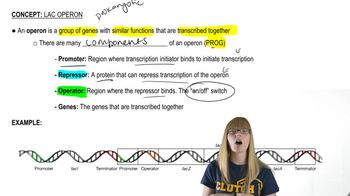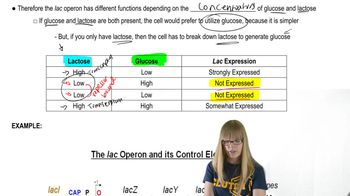- 1. Introduction to Genetics51m
- 2. Mendel's Laws of Inheritance3h 37m
- 3. Extensions to Mendelian Inheritance2h 41m
- 4. Genetic Mapping and Linkage2h 28m
- 5. Genetics of Bacteria and Viruses1h 21m
- 6. Chromosomal Variation1h 48m
- 7. DNA and Chromosome Structure56m
- 8. DNA Replication1h 10m
- 9. Mitosis and Meiosis1h 34m
- 10. Transcription1h 0m
- 11. Translation58m
- 12. Gene Regulation in Prokaryotes1h 19m
- 13. Gene Regulation in Eukaryotes44m
- 14. Genetic Control of Development44m
- 15. Genomes and Genomics1h 50m
- 16. Transposable Elements47m
- 17. Mutation, Repair, and Recombination1h 6m
- 18. Molecular Genetic Tools19m
- 19. Cancer Genetics29m
- 20. Quantitative Genetics1h 26m
- 21. Population Genetics50m
- 22. Evolutionary Genetics29m
12. Gene Regulation in Prokaryotes
Lac Operon
Problem 5b
Textbook Question
For the lac genotypes shown in the following table, predict whether the structural genes (Z) are constitutive, permanently repressed, or inducible in the presence of lactose. Genotype Constitutive Repressed Inducible I⁺O⁺Z⁺ x I⁻O⁺Z⁺ I⁻OᶜZ⁺ I⁻OᶜZ⁺/F'O⁺ I⁺OᶜZ⁺/F'O⁺ IˢO⁺Z⁺ IˢO⁺Z⁺/F'I⁺
 Verified step by step guidance
Verified step by step guidance1
Identify the components of the lac operon: I (repressor gene), O (operator), and Z (structural gene for β-galactosidase).
Understand the role of each component: I⁺ produces a functional repressor, I⁻ produces a non-functional repressor, Iˢ produces a super-repressor, O⁺ is a normal operator, and Oᶜ is a constitutive operator that cannot bind the repressor.
For each genotype, determine the functionality of the repressor and operator: I⁺O⁺Z⁺ has a functional repressor and operator, I⁻O⁺Z⁺ has a non-functional repressor, I⁻OᶜZ⁺ has a non-functional repressor and constitutive operator, etc.
Predict the expression of the Z gene based on the functionality of the repressor and operator: If the repressor cannot bind to the operator (due to I⁻ or Oᶜ), the Z gene is constitutively expressed. If the repressor can bind and is not inhibited by lactose, the Z gene is repressed.
Consider the presence of lactose: In the presence of lactose, a functional repressor (I⁺) will be inhibited, allowing the Z gene to be inducible. A super-repressor (Iˢ) will not be inhibited by lactose, keeping the Z gene repressed.
Recommended similar problem, with video answer:
 Verified Solution
Verified SolutionThis video solution was recommended by our tutors as helpful for the problem above
Video duration:
3mPlay a video:
Was this helpful?
Key Concepts
Here are the essential concepts you must grasp in order to answer the question correctly.
Lac Operon Structure
The lac operon is a genetic regulatory system found in E. coli that controls the metabolism of lactose. It consists of three structural genes (Z, Y, A) and regulatory elements, including the promoter (P) and operator (O). Understanding the operon's structure is crucial for predicting gene expression based on different genotypes, as it determines how the genes respond to the presence or absence of lactose.
Recommended video:
Guided course

Lac Operon Overview
Regulatory Genes and Their Functions
Regulatory genes, such as I (the repressor gene), play a vital role in controlling the expression of the lac operon. The I⁺ allele produces a functional repressor that can bind to the operator, while I⁻ produces a non-functional repressor, allowing for gene expression. The presence of mutations in these regulatory genes affects whether the structural genes are constitutive, repressed, or inducible.
Recommended video:
Guided course

Functional Genomics
Inducibility and Repression Mechanisms
Inducibility refers to the ability of a gene to be expressed in response to an inducer, such as lactose, which binds to the repressor and prevents it from inhibiting transcription. Conversely, repression occurs when the repressor is active and binds to the operator, blocking transcription. Understanding these mechanisms is essential for predicting the behavior of the lac operon under different genetic configurations.
Recommended video:
Guided course

Induced Mutations

 4:27m
4:27mWatch next
Master Lac Operon Overview with a bite sized video explanation from Kylia Goodner
Start learning


